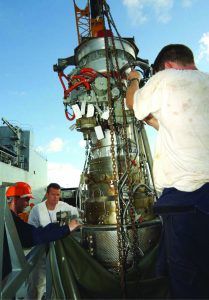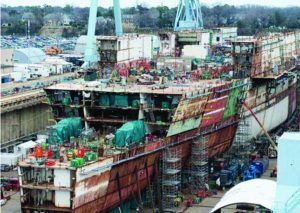MARINE PROPULSION MARKET
GAS TURBINES AND RECIPROCATING ENGINES VIE FOR DEPLOYMENT

Figure 1: Gas turbines are being increasingly deployed in marine applications. Source: Forecast International[/caption]
By Stuart Slade
The gas turbine (GT) is rapidly becoming the standard surface combatant power plant used by navies across the world (Figure 1). The advantages of GTs for warship use include the capability for rapid acceleration and deceleration, low noise, reliability, and power density. In addition, the power plant can be maintained by replacing defective components or removing the whole engine, replacing it with a spare held dockside and sending the defective engine to the manufacturers or a depot for repairs. The design of GTs also facilitates the design of unmanned engine rooms, with consequent crew savings.
Marine GTs have significant limitations, however. They gulp down fuel when used unwisely, are expensive and have a substantial maintenance burden. In addition, they produce a hot exhaust that can damage nearby ship structures and reveal the ships’ position to hostile sensors. These problems can be mitigated by proper design. Although modern gas turbines are fuel efficient when running at constant power settings, they suffer from high fuel consumption when cycling up and down. That can be countered either by providing special low powered cruising turbines or by providing diesels for low speed runs. Another approach is to run the GT at full power all the time and control the speed of the ship using variable-pitch propellers.

Figure 2: Royal Navy Tyne gas turbine being removed for servicing. Source: Royal Navy[/caption]
Warship design
One other aspect of GTs is that they are relatively light. Previously, warship designers were able to use the weight of boilers and machinery low down in the ship to preserve stability against growing topweight. GTs limited this flexibility at a time when new electronics require heavier masthead arrays. Another problem is that GTs require large air intakes and ducting, as well as large enough access paths to the engine room to change out the GT (Figure 2). These problems can be accommodated, though, and there is no other propulsion system that offers the combined merits of GTs. Today, most surface combatants ordered feature gas turbine propulsion, either alone or in combination with diesels.
Despite the universal move to GTs, diesel engines are still the primary power source for the majority of the world’s warships. There are many reasons for this: Diesels are durable and are economical to operate as long as they are not continuously throttled up and down, and the expertise to maintain them is nearly universal. There are few countries that do not have extensive diesel engine support facilities for their civilian economies. They can draw on that infrastructure both for support personnel and for logistics provisions.
Diesel domination
Diesels overwhelmingly dominate the market for propulsion systems for offshore patrol vessels, coast guard cutters, and other maritime policing vessels. These ships also require high reliability, economical use of fuel, and the ability to operate out of poorly equipped ports where the crew has no choice but to rely on a largely civilian-oriented infrastructure. In fact, the maritime policing environment is wholly dominated by the diesel engine to the exclusion of all other options. As the escalating cost of warships forces more nations to restrict their naval ambitions to the maritime policing sector, the dominance of diesels is likely to grow.
Diesels are also used as the cruising power plant of some GT ships, and as the sole propulsion of some smaller frigates. As they tend to consume less fuel than GTs, this reduces the need for fuel bunkerage on ship and extends operating range. In many larger ships, diesel power provides the cruising power for day-to-day running. For many applications this is sufficient; where it is not, one or more GTs can be geared into the powertrain, either to provide boost power or to take over when faster or quieter running is required. These arrangements will remain common.
Experience has shown that gearing diesel engines and gas turbines to the same shaft puts considerable stress on the gears due to the differing operating cycles of the two engines. This can only be avoided by having the diesels and GTs driving separate shafts. The only practical way of achieving this is to use a three- or four-shaft layout, a design quite acceptable on larger warships but troublesome on smaller vessels. This factor suggests that combined diesel or gas (CODOG) rather than combined diesel and gas (CODAG) may dominate future construction.
The problems with diesels stem from the basic operating cycle of the engine. The weight and space constraints quickly become onerous, and diesels tend to be noise generators. Worst of all, they vibrate. To some extent, these problems may be mitigated by using computerized control systems. Diesels, then, will continue to be the primary power source for smaller surface combatants and a major component of the powertrain for larger units. However, smaller types of ships are being replaced by ships in the size bracket where gas turbines become desirable, and thus are in decline. This trend will be balanced by the growth in patrol ships, where the operational economy of a diesel is important.

Figure 4: New Chinese aircraft carrier with gas turbines (covered in blue tarpaulins) on deck waiting for installation. Source: Chinese People's Liberation Forces Navy[/caption]
Electric propulsion
While GTs and diesels will continue to dominate the surface combatant market (Figure 4), the way those power plants will be used is likely to change significantly. Over the last five years, a series of technical advances have turned electric propulsion from a technical backwater into perhaps the predominant form of warship powertrain for the next decade. Electric propulsion in which the ship’s turbines generated electricity that was then used to power electric motors was first used in the 1930s, but it remained a niche system for many years. The modern revival of this system was led by the British, who adopted a combined dieselelectric/ gas turbine (CODLAG) drive system for their Type 23 frigates.
Instead of driving the ship’s propellers directly, diesel engines turn electric generators, which in turn power electric motors that drive the propellers. This arrangement enables diesels to be placed away from the shafts and propellers in sound-insulated compartments. Because the engines are not directly coupled to the shafts, their vibration does not pass along the shaft and thus does not get transmitted to the water as sound. An advantage of the system is that it eliminates the need for gears between the engines and the shaft. By doing so, removes a production bottleneck. The result is an almost silent propulsion system.
CODLAG propulsion systems are very expensive, though, and are not likely to be widely adopted for surface ships. However, their demonstrated advantages persuaded the British to extend the use of electric propulsion to other types of ships. The primary beneficiaries have been the new amphibious warfare ships that employ a simplified diesel-electric drive. This has acted as a bridge to the new integrated fully electric propulsion (IFEP), where ships will use gas turbines as generators for all electrical requirements. The power output from all generators on board is fed into a central pool, from which it is allocated to the requirements of the vessel at any given time.
IFEP is now becoming the primary propulsion system for future generations of surface combatants. The main advantage of IFEP drive systems over conventional drivetrains is that the power source and drive units can be separated from one another and the power unit can supply electrical power to the ship when it is not used for the propulsion plant. They also allow close subdivision of the machinery spaces, reducing vulnerability and providing great flexibility in how power loads can be accommodated. These advantages are too valuable to give up. As a result, the U.S. Navy and Royal Navy have both instituted programs to further explore the use of advanced electric drive technology.
Author: Stuart Slade is the Senior I&M Gas Turbines Analyst at Forecast International. This article provides data taken compiled from the Forecast International Industrial and Marine Gas Turbine Database, a comprehensive listing of more than 41,150 gas turbine installations, of which 3,916 (9.51%) are marine gas turbines used for propulsion and 933 (2.27%) are gas turbines used for onboard power generation. For more information, visit: www.forecastinternational.com